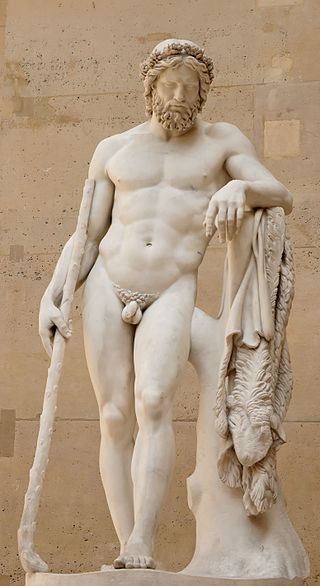
Aristaeus was the mythological culture hero credited with the discovery of many rural useful arts and handicrafts, including bee-keeping; he was the son of the huntress Cyrene and Apollo.
In Inuit mythology, an inua is a spirit or soul that exists in all people, animals, lakes, mountains, and plants. This is not an individual soul, but rather "the vital force representing a chain or continuum of all the individual spirits of that genus which had lived, were living, or were to live."

A mask is an object normally worn on the face, typically for protection, disguise, performance, or entertainment, and often employed for rituals and rites. Masks have been used since antiquity for both ceremonial and practical purposes, as well as in the performing arts and for entertainment. They are usually worn on the face, although they may also be positioned for effect elsewhere on the wearer's body.

African art describes the modern and historical paintings, sculptures, installations, and other visual culture from native or indigenous Africans and the African continent. The definition may also include the art of the African diasporas, such as: African-American, Caribbean or art in South American societies inspired by African traditions. Despite this diversity, there are unifying artistic themes present when considering the totality of the visual culture from the continent of Africa.

Ancient art refers to the many types of art produced by the advanced cultures of ancient societies with different forms of writing, such as those of ancient China, India, Mesopotamia, Persia, Palestine, Egypt, Greece, and Rome. The art of pre-literate societies is normally referred to as prehistoric art and is not covered here. Although some pre-Columbian cultures developed writing during the centuries before the arrival of Europeans, on grounds of dating these are covered at pre-Columbian art and articles such as Maya art, Aztec art, and Olmec art.

A wind vane, weather vane, or weathercock is an instrument used for showing the direction of the wind. It is typically used as an architectural ornament to the highest point of a building. The word vane comes from the Old English word fana, meaning "flag".

A Chiwara is a ritual object representing an antelope, used by the Bambara ethnic group in Mali. The Chiwara initiation society uses Chiwara masks, as well as dances and rituals associated primarily with agriculture, to teach young Bamana men social values as well as agricultural techniques.

Homer Dodge Martin was an American artist, particularly known for his landscape paintings. Examples of Martin's work are in many important American museums.
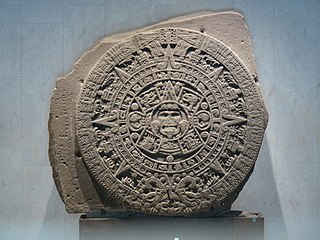
Pre-Columbian art refers to the visual arts of indigenous peoples of the Caribbean, North, Central, and South Americas from at least 13,000 BCE to the European conquests starting in the late 15th and early 16th centuries. The Pre-Columbian era continued for a time after these in many places, or had a transitional phase afterwards. Many types of perishable artifacts that were once very common, such as woven textiles, typically have not been preserved, but Precolumbian monumental sculpture, metalwork in gold, pottery, and painting on ceramics, walls, and rocks have survived more frequently.
Ancient Maya art comprises the visual arts of the Maya civilization, an eastern and south-eastern Mesoamerican culture made up of a great number of small kingdoms in present-day Mexico, Guatemala, Belize and Honduras. Many regional artistic traditions existed side by side, usually coinciding with the changing boundaries of Maya polities. This civilization took shape in the course of the later Preclassic Period, when the first cities and monumental architecture started to develop and the hieroglyphic script came into being. Its greatest artistic flowering occurred during the seven centuries of the Classic Period.
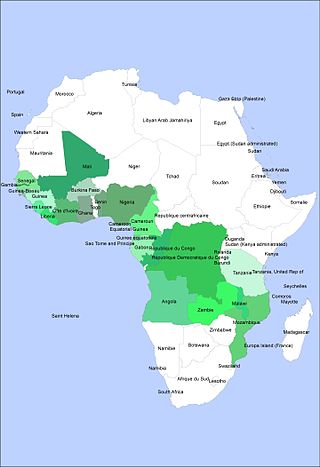
Traditional African masks are worn in ceremonies and rituals across West, Central, and Southern Africa. They are used in events such as harvest celebrations, funerals, rites of passage, weddings, and coronations. Some societies also use masks to resolve disputes and conflicts.

Most African sculpture was historically in wood and other organic materials that have not survived from earlier than at most a few centuries ago; older pottery figures are found from a number of areas. Masks are important elements in the art of many peoples, along with human figures, often highly stylized. There is a vast variety of styles, often varying within the same context of origin depending on the use of the object, but wide regional trends are apparent; sculpture is most common among "groups of settled cultivators in the areas drained by the Niger and Congo rivers" in West Africa. Direct images of African deities are relatively infrequent, but masks in particular are or were often made for traditional African religious ceremonies; today many are made for tourists as "airport art". African masks were an influence on European Modernist art, which was inspired by their lack of concern for naturalistic depiction.

The Folklore Museum at Mysore, India, is a museum which exhibits folk art and crafts from all over the state of Karnataka

Idia was the mother of Esigie, who reigned as Oba (king) of the Edo people from 1504 to 1550. Historians do know that Idia was alive during the Idah war because she played a role that led to a great Benin victory. It has been argued that Idia, therefore, was the true power behind the throne of her son. She played a significant role in the rise and reign of her son, being described as a great warrior who fought relentlessly before and during her son's reign as the Oba (king) of the Edo people. Queen Idia was instrumental in securing the title of Oba for her son Esigie following the death of his father Oba Ozolua. To that end, she raised an army to fight off his brother Arhuaran who was supposed to be the Oba by right and tradition but was subsequently defeated in battle. Esigie’s mother became the 17th Oba of Benin.
A north wind is a wind that originates in the north and blows in a southward direction. The north wind has had historical and literary significance, since it often signals cold weather and seasonal change in the Northern hemisphere. In the Southern Hemisphere, especially in southern Australia, the north wind is a hot wind which often leads to bushfires.

The Poplars series paintings were made by Claude Monet in the summer and fall of 1891. The trees were in a marsh along the banks of the Epte River a few kilometers upstream from Monet's home and studio. To reach his floating painting studio that was moored in a place he went by small boat up the nearby waterway to where it joined the mainstream. The trees were along the riverside in single file, following along an S-curve. There were three groups of paintings — in one group the paintings have towering Poplars that go off the top edge of the canvas, in another group, there are seven trees and in another group three or four Poplars on the banks of the Epte River near Giverny. The trees, which actually belonged to the commune of Limetz, were put up for auction before Monet had completed all of his paintings. At a certain point, Monet was forced into buying the trees because he still wasn't finished with his paintings. After he finished the series he sold the trees back to the lumber merchant who wanted them.

The visual arts of the Indigenous peoples of the Americas encompasses the visual artistic practices of the Indigenous peoples of the Americas from ancient times to the present. These include works from South America and North America, which includes Central America and Greenland. The Siberian Yupiit, who have great cultural overlap with Native Alaskan Yupiit, are also included.
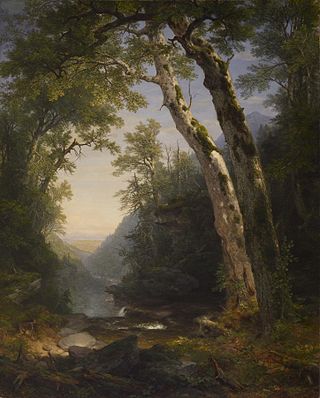
The Catskills by Asher Brown Durand, an American engraver, portraitist, and landscape artist, was commissioned by William Thompson Walters in 1858.

The Benin ivory mask is a miniature sculptural portrait in ivory of Idia, the first Iyoba of the 16th century Benin Empire, taking the form of a traditional African mask. The masks were looted by the British from the palace of the Oba of Benin in the Benin Expedition of 1897.
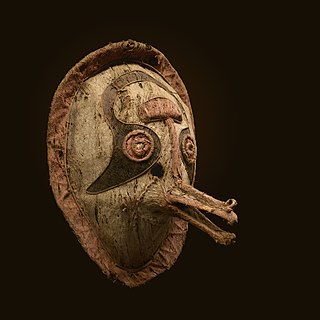
Eharo masks were a type of mask used by the Elema people of the eastern Gulf of Papua as part of the "hevehe" cycle of masked rituals. These masks were crafted from barkcloth, vegetable fiber, and various pigments.


















